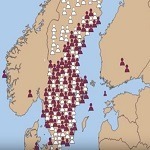It was by accident that the Official Statistics of Sweden revealed that Sweden is importing highly fertile Africans to hide the country’s child-friendly policy failure.
All productive white nations are in a demographic decline, and so is Sweden. The feminist authorities in Sweden maintain that they can combine gender equality, which among others translates into a high women labour participation, with a childbearing level that is sufficient to sustain the welfare state. The Swedish media and academics proclaimed over and over again that Swedish women are outstanding in giving birth to children. It is a widely published fact that the country’s childbearing is close to the replacement rate of 2.1.
However, a closer look at the data reveals that Swedish women’s fertility is a meagre 1.66, i.e. as low as the Dutch and slightly better than German. The data of the Official Statistics of Sweden also shows that Sweden in order to meet its demographic objectives is importing highly fertile women from the world’s most impoverished countries.
Many scientific papers are praising the ability of the progressive Swedish government for being successful in encouraging much more births than the European average. A scientific article published in 2014 stated: “Ambitious family policy is commonly seen as the main reason for the strong position of women in the labour market (among the highest female labour force participation rates in the EU) but also for relatively high fertility (almost at replacement level) and low poverty among children (among the lowest in the EU). Generous spending on family benefits, flexible leave and working hours for parents with young children and affordable, high-quality childcare are seen as the main factors for success.”1)Family Policies: Sweden (2014), Perfar – Population Europe Resource Finder and Archive.
Scientists know that there is a difference in fertility between non-Western and Western women. Failure to take this into account will result in arriving at wrong conclusions.
The Official Statistics of Sweden was not able (or did not want) to provide us with the information about the fertility of Swedish-born and non-Swedish born women. The Gefira team, therefore, made its own rough assessment. To compare the fertility of non Swedish-born women and Swedish born women, we separated the non-Swedish born women from the Swedish born women as well as children with one or two migrant parents. Our first estimate shows that the fertility of women born in Sweden is much lower and in 2015 it stood at 1.57.
Then, accidentally, we discovered that the Official Statistics of Sweden has the data that we had asked for, even in greater detail than we had hoped for. We assume that 2018 resembles the 2017 situation. According to the information for 2018, the fertility of Swedish born women is 1.66, i.e. far below replacement and much lower than the official 1.91 children per woman for all women in Sweden. The Swedish officials are fully aware that the white Swedish women cannot sustain the Swedish society and that the Nordic countries parental system is an expensive failure. More stunning is that the Swedish government compensates the low Swedish fertility by importing highly fertile women from underdeveloped countries with a Low Human Development Index (HDI)

References
| 1. | ↑ | Family Policies: Sweden (2014), Perfar – Population Europe Resource Finder and Archive. |






3 comments on “Highly fertile women from Africa are the secret of Swedish high birth rate”
France is also having high fertility, but who is having the children? Is it the native french women? Or the immigrant women? Can you make an article on the demographic situation in France?
“Native” hmmm, how much do you know about the “French”?
#SwedishGenocide
#WhiteGenocide